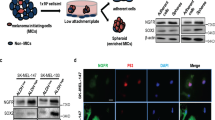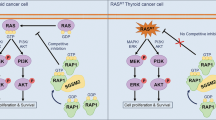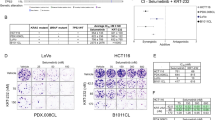Abstract
Genetic alterations in human cancers and murine models indicate that retinoblastoma (Rb) and p53 have critical tumor suppressive functions in retinoblastoma, a tumor of neural origin, and neuroendocrine tumors including small cell lung cancer and medullary thyroid cancer (MTC). Rb inactivation is the initiating lesion in retinoblastoma and current models propose that induction of apoptosis is a key p53 tumor suppressive function. Genetic studies in mice, however, indicate that other undefined p53 tumor suppressive functions are operative in vivo. How p53 loss cooperates with Rb inactivation to promote carcinogenesis is also not fully understood. In the current study, genetically engineered mice were generated to determine the role of Rb and p53 in MTC pathogenesis and test the hypothesis that p53 suppresses carcinogenesis by inhibiting mammalian target of rapamycin (mTOR) signaling. Conditional Rb ablation resulted in thyroid tumors mimicking human MTC, and additional p53 loss led to rapid tumor progression. p53 suppressed tumorigenesis by inhibiting cell cycle progression, but did not induce apoptosis. On the contrary, p53 loss led to increased apoptosis that had to be overcome for tumor progression. The mTOR activity was markedly increased in p53-deficient tumors and rapamycin treatment suppressed tumor cell growth, identifying mTOR inhibition as a critical p53 tumor suppressive function. Rapamycin treatment did not result in AKT/mitogen-activated protein kinase activation, providing evidence that this feedback mechanism operative in other cancers is not a general response to mTORC1 inhibition. Together, these studies provide mechanistic links between genetic alterations and aberrant signaling pathways critical in carcinogenesis, and identify essential Rb and p53 tumor suppressive functions in vivo.
This is a preview of subscription content, access via your institution
Access options
Subscribe to this journal
Receive 50 print issues and online access
$259.00 per year
only $5.18 per issue
Buy this article
- Purchase on Springer Link
- Instant access to full article PDF
Prices may be subject to local taxes which are calculated during checkout







Similar content being viewed by others
References
Levine AJ, Oren M . The first 30 years of p53: growing ever more complex. Nat Rev Cancer 2009; 9: 749–758.
Stiewe T . The p53 family in differentiation and tumorigenesis. Nat Rev Cancer 2007; 7: 165–168.
Vousden KH, Prives C . Blinded by the light: the growing complexity of p53. Cell 2009; 137: 413–431.
Liu G, Parant JM, Lang G, Chau P, Chavez-Reyes A, El-Naggar AK et al. Chromosome stability, in the absence of apoptosis, is critical for suppression of tumorigenesis in Trp53 mutant mice. Nat Genet 2004; 36: 63–68.
Feng Z, Levine AJ . The regulation of energy metabolism and the IGF-1/mTOR pathways by the p53 protein. Trends Cell Biol 2010; 20: 427–434.
Hasty P, Sharp ZD, Curiel TJ, Campisi J . mTORC1 and p53: clash of the gods? Cell Cycle 2013; 12: 20–25.
Conkrite K, Sundby M, Mu D, Mukai S, MacPherson D . Cooperation between Rb and Arf in suppressing mouse retinoblastoma. J Clin Invest 2012; 122: 1726–1733.
Laurie NA, Donovan SL, Shih CS, Zhang J, Mills N, Fuller C et al. Inactivation of the p53 pathway in retinoblastoma. Nature 2006; 444: 61–66.
Wikenheiser-Brokamp KA . Retinoblastoma regulatory pathway in lung cancer. Curr Mol Med 2006; 6: 783–793.
Meuwissen R, Linn SC, Linnoila RI, Zevenhoven J, Mooi WJ, Berns A . Induction of small cell lung cancer by somatic inactivation of both Trp53 and Rb1 in a conditional mouse model. Cancer Cell 2003; 4: 181–189.
Harvey M, Vogel H, Lee EY, Bradley A, Donehower LA . Mice deficient in both p53 and Rb develop tumors primarily of endocrine origin. Cancer Res 1995; 55: 1146–1151.
Nikitin AY, Juarez-Perez MI, Li S, Huang L, Lee WH . RB-mediated suppression of spontaneous multiple neuroendocrine neoplasia and lung metastases in Rb+/- mice. Proc Natl Acad Sci USA 1999; 96: 3916–3921.
Williams BO, Remington L, Albert DM, Mukai S, Bronson RT, Jacks T . Cooperative tumorigenic effects of germline mutations in Rb and p53. Nat Genet 1994; 7: 480–484.
Cerrato A, De Falco V, Santoro M . Molecular genetics of medullary thyroid carcinoma: the quest for novel therapeutic targets. J Mol Endocrinol 2009; 43: 143–155.
Pitt SC, Moley JF . Medullary, anaplastic, and metastatic cancers of the thyroid. Semin Oncol 2010; 37: 567–579.
Sippel RS, Kunnimalaiyaan M, Chen H . Current management of medullary thyroid cancer. Oncologist 2008; 13: 539–547.
Wu LS, Roman SA, Sosa JA . Medullary thyroid cancer: an update of new guidelines and recent developments. Curr Opin Oncol 2011; 23: 22–27.
Almeida MQ, Hoff AO . Recent advances in the molecular pathogenesis and targeted therapies of medullary thyroid carcinoma. Curr Opin Oncol 2012; 24: 229–234.
Smith-Hicks CL, Sizer KC, Powers JF, Tischler AS, Costantini F . C-cell hyperplasia, pheochromocytoma and sympathoadrenal malformation in a mouse model of multiple endocrine neoplasia type 2B. EMBO J 2000; 19: 612–622.
Moura MM, Cavaco BM, Pinto AE, Leite V . High prevalence of RAS mutations in RET-negative sporadic medullary thyroid carcinomas. J Clin Endocrinol Metabol 2011; 96: E863–E868.
Rapa I, Saggiorato E, Giachino D, Palestini N, Orlandi F, Papotti M et al. Mammalian target of rapamycin pathway activation is associated to RET mutation status in medullary thyroid carcinoma. J Clin Endocrinol Metabol 2011; 96: 2146–2153.
Goutas N, Vlachodimitropoulos D, Bouka M, Lazaris AC, Nasioulas G, Gazouli M . BRAF and K-RAS mutation in a Greek papillary and medullary thyroid carcinoma cohort. Anticancer Res 2008; 28: 305–308.
Kouvaraki MA, Liakou C, Paraschi A, Dimas K, Patsouris E, Tseleni-Balafouta S et al. Activation of mTOR signaling in medullary and aggressive papillary thyroid carcinomas. Surgery 2011; 150: 1258–1265.
Tamburrino A, Molinolo AA, Salerno P, Chernock RD, Raffeld M, Xi L et al. Activation of the mTOR pathway in primary medullary thyroid carcinoma and lymph node metastases. Clin Cancer Res 2012; 18: 3532–3540.
Carracedo A, Ma L, Teruya-Feldstein J, Rojo F, Salmena L, Alimonti A et al. Inhibition of mTORC1 leads to MAPK pathway activation through a PI3K-dependent feedback loop in human cancer. J Clin Invest 2008; 118: 3065–3074.
Simpson DS, Mason-Richie NA, Gettler CA, Wikenheiser-Brokamp KA . Retinoblastoma family proteins have distinct functions in pulmonary epithelial cells in vivo critical for suppressing cell growth and tumorigenesis. Cancer Res 2009; 69: 8733–8741.
Perl AK, Wert SE, Nagy A, Lobe CG, Whitsett JA . Early restriction of peripheral and proximal cell lineages during formation of the lung. Proc Natl Acad Sci USA 2002; 99: 10482–10487.
Matthew EM, Hart LS, Astrinidis A, Navaraj A, Dolloff NG, Dicker DT et al. The p53 target Plk2 interacts with TSC proteins impacting mTOR signaling, tumor growth and chemosensitivity under hypoxic conditions. Cell Cycle 2009; 8: 4168–4175.
Wikenheiser-Brokamp KA . Rb family proteins differentially regulate distinct cell lineages during epithelial development. Development 2004; 131: 4299–4310.
Frisk T, Zedenius J, Lundberg J, Wallin G, Kytola S, Larsson C . CGH alterations in medullary thyroid carcinomas in relation to the RET M918T mutation and clinical outcome. Int J Oncol 2001; 18: 1219–1225.
Hemmer S, Wasenius VM, Knuutila S, Franssila K, Joensuu H . DNA copy number changes in thyroid carcinoma. Am J Pathol 1999; 154: 1539–1547.
Marsh DJ, Theodosopoulos G, Martin-Schulte K, Richardson AL, Philips J, Roher HD et al. Genome-wide copy number imbalances identified in familial and sporadic medullary thyroid carcinoma. J Clin Endocrinol Metabol 2003; 88: 1866–1872.
Anwar F, Emond MJ, Schmidt RA, Hwang HC, Bronner MP . Retinoblastoma expression in thyroid neoplasms. Mod Pathol 2000; 13: 562–569.
Basolo F, Caligo MA, Pinchera A, Fedeli F, Baldanzi A, Miccoli P et al. Cyclin D1 overexpression in thyroid carcinomas: relation with clinico-pathological parameters, retinoblastoma gene product, and Ki67 labeling index. Thyroid 2000; 10: 741–746.
Holm R, Nesland JM . Retinoblastoma and p53 tumour suppressor gene protein expression in carcinomas of the thyroid gland. J Pathol 1994; 172: 267–272.
Herfarth KK, Wick MR, Marshall HN, Gartner E, Lum S, Moley JF . Absence of TP53 alterations in pheochromocytomas and medullary thyroid carcinomas. Genes Chromosomes Cancer 1997; 20: 24–29.
Hinze R, Gimm O, Taubert H, Bauer G, Dralle H, Holzhausen HJ et al. Regulation of proliferation and apoptosis in sporadic and hereditary medullary thyroid carcinomas and their putative precursor lesions. Virch Arch 2000; 437: 256–263.
Yoshimoto K, Iwahana H, Fukuda A, Sano T, Saito S, Itakura M . Role of p53 mutations in endocrine tumorigenesis: mutation detection by polymerase chain reaction-single strand conformation polymorphism. Cancer Res 1992; 52: 5061–5064.
Pavelic K, Dedivitis RA, Kapitanovic S, Cacev T, Guirado CR, Danic D et al. Molecular genetic alterations of FHIT and p53 genes in benign and malignant thyroid gland lesions. Mut Res 2006; 599: 45–57.
Sheikh HA, Tometsko M, Niehouse L, Aldeeb D, Swalsky P, Finkelstein S et al. Molecular genotyping of medullary thyroid carcinoma can predict tumor recurrence. Am J Surg Pathol 2004; 28: 101–106.
Wander SA, Hennessy BT, Slingerland JM . Next-generation mTOR inhibitors in clinical oncology: how pathway complexity informs therapeutic strategy. J Clin Invest 2011; 121: 1231–1241.
Laplante M, Sabatini DM . mTOR signaling in growth control and disease. Cell 2012; 149: 274–293.
Freed-Pastor WA, Prives C . Mutant p53: one name, many proteins. Genes Dev 2012; 26: 1268–1286.
Faggiano A, Ramundo V, Dicitore A, Castiglioni S, Borghi MO, Severino R et al. Everolimus is an active agent in medullary thyroid cancer: a clinical and in vitro study. J Cell Mol Med 2012; 16: 1563–1572.
Grozinsky-Glasberg S, Rubinfeld H, Nordenberg Y, Gorshtein A, Praiss M, Kendler E et al. The rapamycin-derivative RAD001 (everolimus) inhibits cell viability and interacts with the Akt-mTOR-p70S6K pathway in human medullary thyroid carcinoma cells. Mol Cell Endocrinol 2010; 315: 87–94.
Dong M, Phan AT, Yao JC . New strategies for advanced neuroendocrine tumors in the era of targeted therapy. Clin Cancer Res 2012; 18: 1830–1836.
Vilar E, Perez-Garcia J, Tabernero J . Pushing the envelope in the mTOR pathway: the second generation of inhibitors. Mol Cancer Ther 2011; 10: 395–403.
Marino S, Vooijs M, van Der Gulden H, Jonkers J, Berns A . Induction of medulloblastomas in p53-null mutant mice by somatic inactivation of Rb in the external granular layer cells of the cerebellum. Genes Dev 2000; 14: 994–1004.
Wikenheiser KA, Vorbroker DK, Rice WR, Clark JC, Bachurski CJ, Oie HK et al. Production of immortalized distal respiratory epithelial cell lines from surfactant protein C/simian virus 40 large tumor antigen transgenic mice. Proc Natl Acad Sci USA 1993; 90: 11029–11033.
Wise-Draper TM, Allen HV, Jones EE, Habash KB, Matsuo H, Wells SI . Apoptosis inhibition by the human DEK oncoprotein involves interference with p53 functions. Mol Cell Biol 2006; 26: 7506–7519.
Acknowledgements
We thank Mingyan Yang and Susan E Wert for technical expertise, Veterinary Services for excellent animal care, and Susanne I Wells and Elizabeth E Hoskins for reagents and technical expertise. This work was supported by grants from the American Cancer Society RSG-10-194-01-TBG and NIH/NHLBI RO1 HL079193 (to KAW-B).
Author information
Authors and Affiliations
Corresponding author
Ethics declarations
Competing interests
The authors declare no conflict of interest.
Additional information
Supplementary Information accompanies this paper on the Oncogene website
Rights and permissions
About this article
Cite this article
Akeno, N., Miller, A., Ma, X. et al. p53 suppresses carcinoma progression by inhibiting mTOR pathway activation. Oncogene 34, 589–599 (2015). https://doi.org/10.1038/onc.2013.589
Received:
Revised:
Accepted:
Published:
Issue Date:
DOI: https://doi.org/10.1038/onc.2013.589
Keywords
This article is cited by
-
Multi-omics analysis identifies RFX7 targets involved in tumor suppression and neuronal processes
Cell Death Discovery (2023)
-
p53-mediated AKT and mTOR inhibition requires RFX7 and DDIT4 and depends on nutrient abundance
Oncogene (2022)
-
CHMP1A suppresses the growth of renal cell carcinoma cells via regulation of the PI3K/mTOR/p53 signaling pathway
Genes & Genomics (2022)
-
P53 Gene Mutation Identified by Next Generation Sequencing in Poorly Differentiated Neuroendocrine Carcinoma of the Nasal Cavity
Head and Neck Pathology (2019)
-
p16 controls epithelial cell growth and suppresses carcinogenesis through mechanisms that do not require RB1 function
Oncogenesis (2017)



